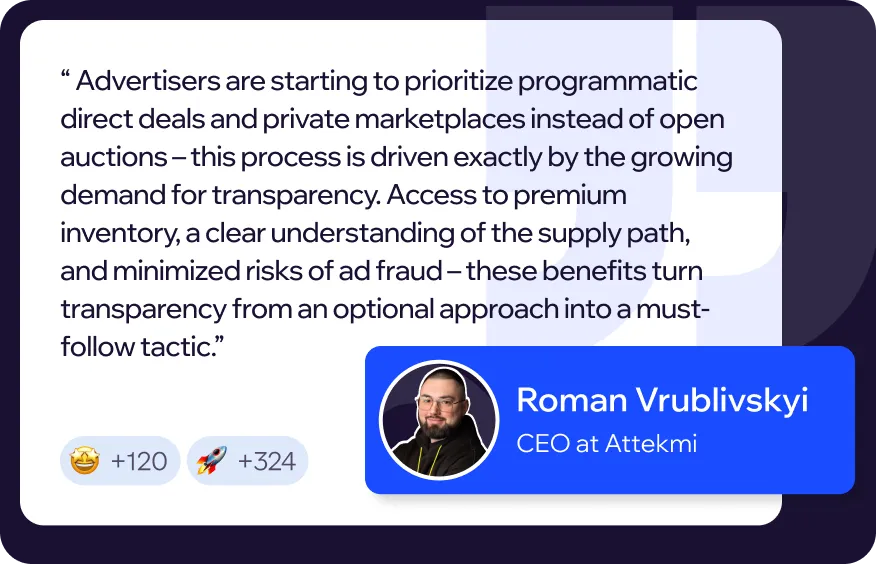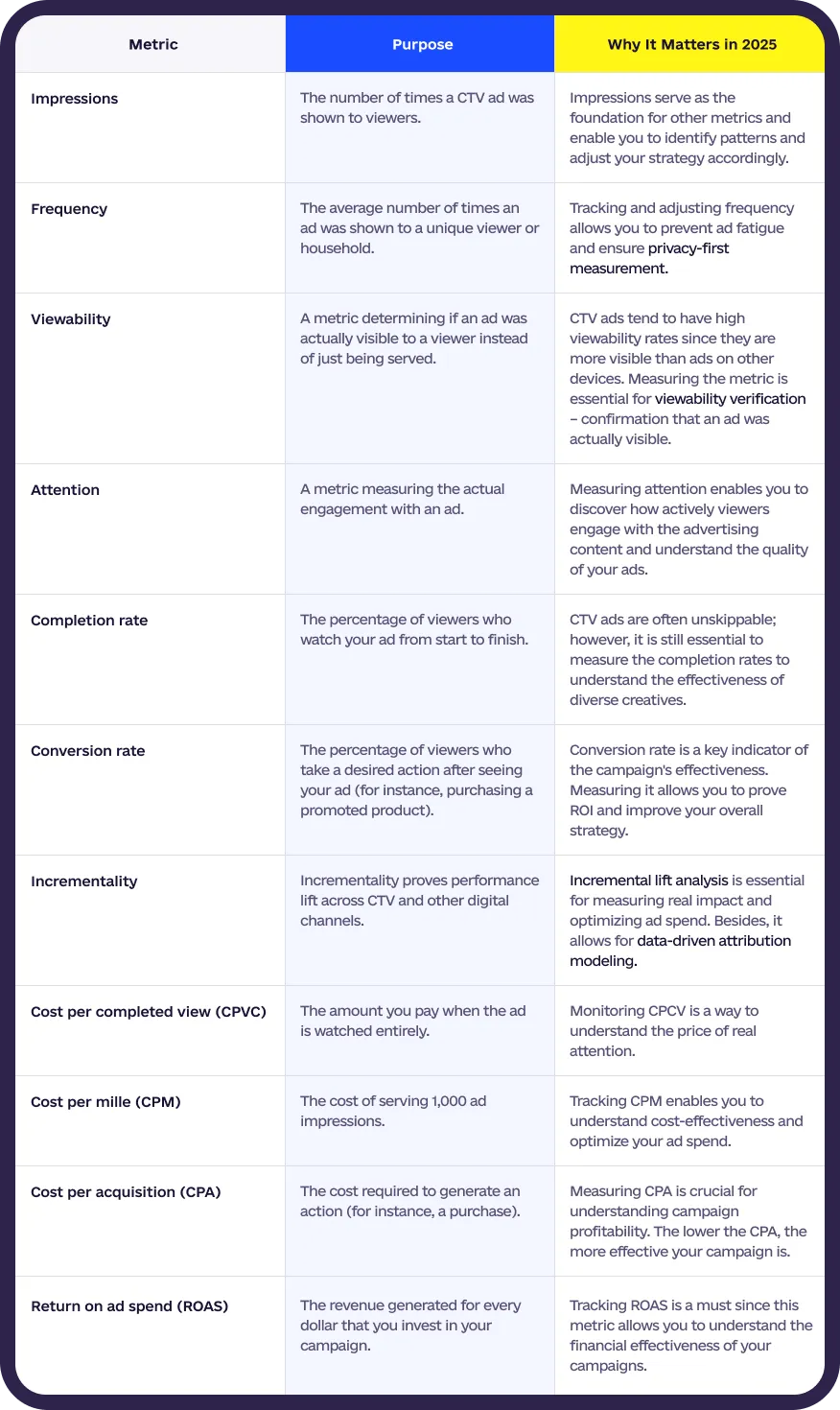CTV (Connected TV) advertising keeps gaining momentum. According to Statista, global CTV ad spending was expected to exceed $29 billion. By 2027, this figure is projected to reach over $38 billion.
However, just like in the case of any other channel or ad format, the efficiency of the campaign heavily relies on continuous analysis. So, how to measure TV advertising? What are the key CTV metrics to pay attention to?
This guide is here to provide you with actionable insights on CTV analytics, so keep reading to discover how to make the most of your campaigns.
Key Takeaways:
Transparency remains among the key challenges related to CTV measurement, as many platforms do not provide enough data on campaign performance.
The key metrics include, but are not limited to, impressions, viewability, completion rate, and conversion rate. However, you should prioritize those metrics that directly reflect your goals.
Launching your own ad exchange can help you increase transparency and gain greater control over your advertising processes.
Ad exchange solutions from Attekmi enable you to avoid a long and expensive process of custom development.
The evolution of CTV measurement
CTV advertising is considered to be challenging in terms of analysis; however, with the evolution of technology, things have gotten much simpler. Thus, in its early days, connected TV ad measurement offered pretty limited capabilities – advertisers could track metrics like impressions and completion rates, but other insights were inaccessible. The growth of the ecosystem solved this issue, so it became possible to connect viewership data with behavioral and demographic signals. As a result, TV advertising measurement started implying granular audience insights.
The key milestones are as follows:
The rise of cross-device tracking enabled a more complete view of the customer journey, as well as effective cross-platform campaign measurement.
The introduction of unified IDs that replaced cookies to maintain audience consistency across platforms.
The introduction of privacy regulations (like, for instance, GDPR and CCPA) reshaped the CTV advertising landscape, pushing AdTech providers to develop privacy-safe, consent-based measurement frameworks.
2025 challenges in measuring CTV campaigns
Even though TV campaign tracking has evolved significantly, certain challenges are still in place. Fortunately, there are ways to solve them. Let’s review the key pain points, limitations, and solutions related to connected TV measurement.

In general, transparency remains the top challenge. Fragmented ecosystems, inconsistent data standards, and limited visibility into supply chains make it difficult for advertisers to assess real CTV performance. These issues, along with the continuous risk of ad fraud, result in the need for greater transparency and media supply-chain visibility.
Why transparency matters more than ever
In March 2024, Pixalate found that open programmatic CTV traffic carried an average 17% invalid traffic (IVT) rate, with specific apps exceeding that percentage – for instance, Food Network GO (46%) on Amazon Fire TV and Xumo Play (23%) on Roku.
The results of the research prove the growing need for transparency in the programmatic infrastructure. However, transparency is essential not only to minimize invalid traffic and secure ad spend.
First and foremost, transparency directly affects ROI measurement. In the specific case outlined above, around one-fifth of CTV impressions might be invalid, which means that advertisers can’t calculate ROI accurately. Transparent measurement, including shared log-level reporting data and impression reports, becomes crucial for brands to distinguish genuine inventory from fraudulent activity.
Secondly, transparency plays a vital role in ensuring brand safety and building trust. A clear understanding of the supply path and verification mechanisms helps businesses make sure that ads are displayed in brand-safe contexts.
Last but not least, transparency is essential in terms of scalability. Without consistent, clear metrics across different platforms, expanding CTV campaigns becomes risky. In turn, standardized transparency frameworks allow you to scale with confidence.

Key metrics to track in 2025
How to measure TV advertising effectiveness? Tracking impressions and frequency is not enough, although monitoring these CTV KPIs is still a must. To get a deep understanding of your campaign performance and optimize your strategy accordingly, you need to keep an eye on multiple metrics. Here are the most essential ones.

Now you know how to evaluate TV advertising; however, it is important to remember that you should prioritize those metrics that directly reflect your goals. Besides, remember that the metrics should be monitored continuously. If you check them only from time to time, it will be challenging for you to fine-tune your strategy properly.
How white-label ad exchanges enable transparent CTV ad measurement
The majority of modern demand-side platforms (DSPs) offer CTV advertising capabilities, and you, as a marketer, need to use one of them to launch your campaigns programmatically. However, this is not the only AdTech solution you can leverage – having your own ad exchange can help you connect with the most relevant supply-side platforms (SSPs) and get a better understanding of how your ads are performing.
Launching such a platform does not have to be an expensive and time-consuming process. At Attekmi, we offer a variety of ad exchange solutions, including a white-label one:
AdEx Basic: An entry-level platform with basic functionalities.
AdEx Plus: An enhanced version of AdEx Basic.
AdEx Enterprise: A platform with advanced functionality and an ultimately scalable nature.
White Label Ad Exchange: A fully customizable platform, from UI personalization to custom on-request feature development.
Besides, CTV is not the only environment supported by our platforms. Other options include desktop, mobile web, and in-app channels – this provides you with freedom of action.
Launching your own ad exchange solution is a way not only to gain greater control over your ad operations – this will also enable you to start driving media trading income.
Our White Label Ad Exchange gets fully tailored to your needs – it will look and feel like it was developed by your brand.

Conclusion
So, how to track TV advertising effectively? With the metrics outlined in this guide, you will be able to measure the efficiency of your advertising campaigns and adjust your strategy to reach even better results. However, again, you should focus on those metrics that are relevant to your goals. Keeping an eye on all the metrics provided by your platform will help you gain a better understanding of what is going on; however, the metrics reflecting your objectives should be your priority.
Besides, keep in mind that getting your own ad exchange solution will provide you with enhanced control over your CTV ad operations. With Attekmi, your platform will be launched in the shortest time possible and with minimal investment.
Ready to launch your own ad exchange platform? Contact us!
FAQ
To calculate ROI, subtract your CTV campaign costs from the generated revenue. Divide the result by cost and then multiply by 100.
You should select the metrics according to your goals. However, the key ones are impressions, frequency, viewability, attention, conversion rate, completion rate, incrementality, cost per completed view (CPVC), cost per mille (CPM), cost per acquisition (CPA), and return on ad spend (ROAS).
To gain greater control and transparency without the cost and delay of custom development. White-label platforms offer faster deployment, built-in compliance, and effective optimization functionalities, allowing you to manage programmatic supply chains and build long-term value.
 By Iryna Kozirevych
By Iryna Kozirevych